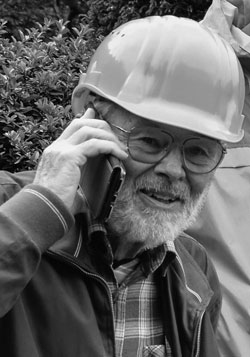A dedicated engineering geologist and prolific writer, always with a funny story up his sleeve

Pieter (Michiel in the Netherlands) was familiar with geology from a young age. His parents met while studying geology at Leiden University, Netherlands. His father, a palaeontologist, worked abroad for the oil industry, which meant Pieter became accustomed to travel and new experiences from the age of two. It also meant he got an Anglo-American education while living in Caracas (Venezuela), Bogota (Colombia), Tripoli (Libya) and the UK.
Pieter got his degrees at University College London (Civil Engineering) and Imperial College London (Engineering Geology).
Work abroad
Pieter’s first job in 1969 was as research officer at the National Institute for Road Research in South Africa investigating causes of distress and failures of road embankments constructed on slopes. In 1973, he returned to the UK to work with Binnie & Partners on a variety of local projects, one resulting in the paper ‘
The dirtiest river of England’ (the Tame). In 1976, Pieter joined Fugro in the Netherlands. This took him to East Africa, the Middle and Far East, India, and Bangladesh, as well as offshore to do with North Sea oil. Pieter was also manager of Fugro’s Middle East office based in Dubai, where he got to know the geology of the Gulf nations well. He often referred to his experiences there, including one he was proud of: a rock slope pyramid cutting near Muscat in Oman. In 1984, Pieter and a colleague started their own consulting company, Geocom, which meant more work abroad.
Academia
In 1987, life became more settled for Pieter when he joined the Engineering Geology section at Delft Technical University. Professor David Price welcomed Pieter as he brought with him a wealth of experience in practice, which was valued highly. At the university, Pieter could be found in his office surrounded by piles of papers and books, working on improving his spreadsheet programs or writing. His interests included the correlation of geotechnical data with surrounding geology, dam failures (including a detailed analysis of the Malpasset dam failure using stereographic methods), and development of pocket cards that are still used to aid the logging of soil and rock exposures in the field.
During excursions and fieldwork with students, Pieter typically could be seen filling his small notebooks with his observations or measuring features he observed in the rocks. The annual student field trips to Spain allowed him to become an expert in Priorat wines, and to write a paper about the local geology and the vineyards.
Engineering
Pieter was an active member of the Institution of Civil Engineers. For many years, he was the Institution’s representative for the Netherlands. Pieter was also a member of the Engineering Group of the Geological Society, and he always tried to be at their reunions, which met every Friday the 13th at Burlington House. He was a prolific writer with papers in journals and conferences, including many for the newsletter of IngeoKring, of the Dutch Engineering Geology association. At meetings, Pieter always had one or two funny stories up his sleeve to break the ice in a conversation or, in English tradition, honour the host of a gathering with a thank you speech at the dinner table. Retirement did not stop him writing and attending conferences.
Pieter remained single all his life. Engineering Geology, wine, golf and family were his main interests.
By Peter Verhoef, Dominique Ngan-Tillard, Ard den Outer and Paul Maurenbrecher
(Image courtesy of Siefko Slob)